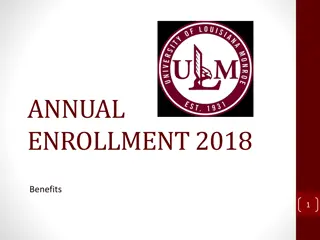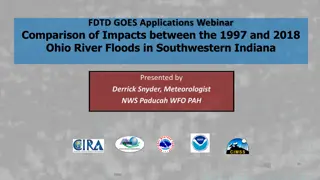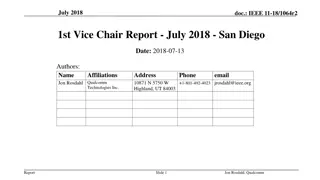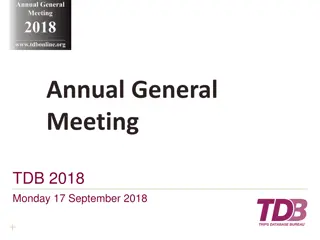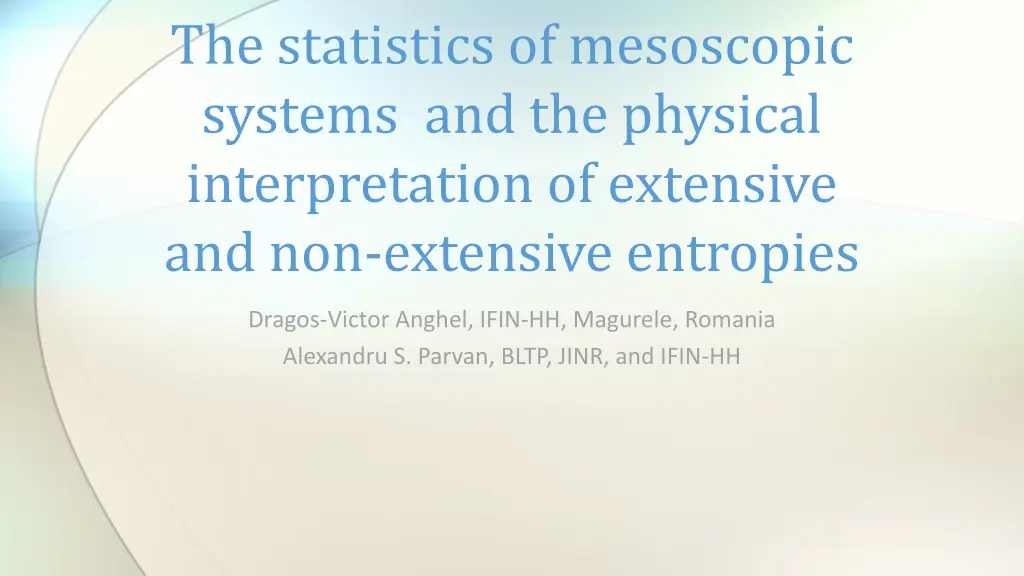
Mesoscopic Systems: Statistics and Entropy Interpretation
Explore the statistics of mesoscopic systems and the interpretation of extensive and non-extensive entropies in this in-depth study. Topics covered include the definition of entropy, equilibrium properties of compound systems, and Tisza-Callen postulates of thermodynamics.
Download Presentation

Please find below an Image/Link to download the presentation.
The content on the website is provided AS IS for your information and personal use only. It may not be sold, licensed, or shared on other websites without obtaining consent from the author. If you encounter any issues during the download, it is possible that the publisher has removed the file from their server.
You are allowed to download the files provided on this website for personal or commercial use, subject to the condition that they are used lawfully. All files are the property of their respective owners.
The content on the website is provided AS IS for your information and personal use only. It may not be sold, licensed, or shared on other websites without obtaining consent from the author.
E N D
Presentation Transcript
The statistics of mesoscopic systems and the physical interpretation of extensive and non-extensive entropies Dragos-Victor Anghel, IFIN-HH, Magurele, Romania Alexandru S. Parvan, BLTP, JINR, and IFIN-HH
Motivation 5.03.2018 BLTP seminar 3
Comparison of Tsallis-factorized statistics with Tsallis-1 statistics pp - collision Tsallis-1 (Model B): Charged massless pions A.S.P., Eur. Phys. J. A 52 (2016) 355 Ex. NA61/SHINE, Eur. Phys. J. C 74, 2794 (2014) Ex. PHENIX, Phys. Rev. C 83, 064903 (2011) Ultrarelativistic distributions of the Tsallis-1 statistics: 3 N 3 N 1 q 1 q 3 N 3 N y y N 2 N 1 1 1 1 q q d N dp dy gV 1 N 2 N 1 1 1 q q 0 1 d N dp dy gV 0 = 2 T cosh p dy y = cosh p y ( ) 2 ( ) ! N T 3 2 2 ! p N 2 = 0 N T = y 0 N y T T 0 0 1 q 1 q 1 1 + 3 N + 3 N + + + + 1 cosh ( 1) q p y N 1 cosh ( 1) q p y N 1 q 1 q + + 1 T 1 T q T q T
Comparison of Tsallis-factorized statistics with Tsallis-1 statistics pp- collision Tsallis-1 (Model B): Charged massless pions A.S.P., Eur. Phys. J. A 52 (2016) 355 Ex. ALICE, Eur. Phys. J. C 71, 1655 (2011); Eur. Phys. J. C 75, 226 (2015) Ex. ALICE, Phys. Lett. B 736, 196 (2014) Ultrarelativistic distributions of the Tsallis-1 statistics: 3 3 N N 1 q 1 q 3 N 3 N y y y y N 2 1 N 1 1 1 q q N 1 2 1 N d N dp dy gV 1 1 1 q q d N dp dy gV 1 1 0 0 = cosh = p dy y 2 T cosh p dy y ( ) T 3 ( ) 2 ! p N 2 ! 2 N 2 = 0 N T T = y 0 N y T y y 0 0 0 0 1 q 1 q 1 1 + 3 N + + + 3 N 1 cosh ( 1) q p y N 1 q + + 1 cosh ( 1) q p y N 1 q + 1 T + 1 T q T q T
Summary Basic considerations and general postulates Definitions and properties of the entropy Three methods to find the equilibrium properties of compound systems Applications of the methods and comparison of the results Conclusions 5.03.2018 BLTP seminar 6
Basic considerations and general postulates 5.03.2018 BLTP seminar 7
Existence of the function entropy The state of a homogeneous system, defined by the extensive parameters (?,?). Reversible, adiabatic processes The entropy variation ? is a measure of the irreversibility of the process ? This formalism is rigorously defined only for macroscopic systems. 5.03.2018 BLTP seminar 8
Tisza-Callen postulates of thermodynamics Postulate 1 (existence of equilibrium states): Any isolated system has equilibrium states that are characterized by a small number of extensive variables ?,? . Postulate 2 (existence of entropy): There exists a function (called entropy ?) of the extensive parameters, defined for all equilibrium states and having the following property. The values assumed by the extensive parameters in the absence of a constraint are those that maximize the entropy over the manifold of constrained equilibrium states. This postulate is an expression of the Second Law of Thermodynamics. Postulate 3 (additivity and differentiability of ?): The entropy of a composite system is additive over the constituent subsystems (whence the entropy of each constituent system is a homogeneous first order function of the extensive parameters). The entropy is continuous and differentiable. The observer appears the anthropomorphism of the entropy (Jaynes, Am. J. Phys. 33, 391, 1965). Macroscopic systems 5.03.2018 BLTP seminar 9
Properties of the entropy Is a function of the extensive parameters ? and ?: ? ?,? The entropy of a macroscopic system is a homogeneous function ? ??,?? = ?? ?,? Is a concave downwards function ? ?1,?1 + ? ?2,?2 ? ?1+ ?2,?1+ ?2 S S 1 ?=?? ?? U U ? > 0 ? = ? < 0 BLTP seminar 5.03.2018 10
Definitions and properties of the entropy 5.03.2018 BLTP seminar 11
Statistical mechanics description of the entropy Extensive parameters (?,?) -> microstates ? , of probabilities ?? The entropy should be a function of the set ??. The average value of any physical quantity ? is ? ???? ? Usually, the microstates are eigenstates of the Hamiltonian 5.03.2018 BLTP seminar 12
Definitions of the entropy Extensive entropies Non-extensive entropies Boltzmann-Gibbs ???= ?? Havrada-Charv t-Daroczy-Tsallis (HCDT) ??ln ?? ? 1 ??? 1 ? ????= ?? ?? ? R nyi Landsberg-Vedral (LV) ? ln ??? 1 ? ?= ?? ?? ?? 1 ??= ?? 1 ? 1 ? ??? ??? ? ???? ?? ?? = lim ?=1 ?? ?? = lim ?=1 ?? ?? = lim ?=1 ?? ?? 5.03.2018 BLTP seminar 13
Boltzmann-Gibbs-Shanon-Rnyi entropy ???is also called the amount of uncertainty concerning the outcome of an experiment. ???is the unique quantity (up to a multiplicative constant) that satisfies the postulates (A. R nyi, 4th Berkeley Symposium 1, 547, 1961; D. K. Fadeev, Arbeiten zur Informationstheorie I, 1957). a. ??? ?? is a symmetric function in its variables. b. ????,1 ? is a continuous function of ? for 0 ? 1. 1 2,1 c. ??? = 1 2 d. ?????1, 1 ? ?1,?2, ,?? = ????1,?2, ,?? + ?1????,1 ? 5.03.2018 BLTP seminar 14
Boltzmann-Gibbs-Shanon-Rnyi entropy additivity property (1) and ?? (2) We have 2 sets of probabilities ?? (1+2), where ??? (1+2)= ?? (1)?? (2) We define the direct product ??? 1+2 1 2 Then ??? = ??? + ??? ??? ?? ?? (additivity property) Postulate d: ?????1, 1 ? ?1,?2, ,?? = ????1,?2, ,?? + ?1????,1 ? Replaced by additivity The Boltzmann-Gibbs-Shanon-R nyi entropies have the right extensivity property, but what are we suppose to do with non-extensive systems? ? ln ??? 1 ? ?= ?? R nyi: ?? 5.03.2018 BLTP seminar 15
Entropies in isolated systems (microcanonical ensemble) For given ?,? , the number of accessible microstates of the system is ?,? All accessible microstates are equiprobable, i.e. ??= 1/ ?,? for any ? Extensive entropies Non-extensive entropies Boltzmann-Gibbs ????,? = ??ln ?,? R nyi ?? Havrada-Charv t-Daroczy-Tsallis (HCDT) 1 ??,? 1 1 ? ?????,? = ?? ?? ??,? = ??ln ?,? Landsberg-Vedral (LV) ?? ???,? = 1 ?1 ? 1?,? ?? 5.03.2018 BLTP seminar 16
Probabilities in compound systems 1 System 1, of microstates ? and probabilities ?? 2 System 2, of microstates ? and probabilities ?? 1+2 System 1 + 2 , of probabilities ??? 1+2= If systems 1 and 2 remain isolated of each other, ??? ?? otherwise we can t say much about the probabilities of the microstates of the system 1 + 2 . 1?? 2, 5.03.2018 BLTP seminar 17
Systems composed of isolated subsystems System 1, of parameters ?1,?1, is isolated 1 1= ?? , ? 1?1,?1 System 2, of parameters ?2,?2, is isolated 1 2= ?? , ? 2?2,?2 System 1 + 2 , of parameters ?1,?2,?1,?2, 1+2= 1?1,?1 2?2,?2 1 ??? , ?,? What happens when two systems, initially isolated, are put into contact? 5.03.2018 BLTP seminar 18
Additive, subadditive and superadditive entropies Extensive entropies Non-extensive entropies 1 ??,? 1 1 ? ????,? = ??ln ?,? ?1+2 = ?1 ?????,? = ?? ???? ?1,?2,?1,?2 ?????1,?1 + ?? 2 ?????1,?1?? 2 ?? ?? 1+2 = ?? 1 +1 ? ???1,?2,?1,?? ???1,?1 + ?2 ???2,?? ?????2,?2 ?????2,?2 ?? 1 ??,? = ??ln ?,? ?1+2 ?1,?2,?1,?? = ?1 ?? ?? ? ?? 1 ?1 ? 1?,? ?1,?2,?1,?2 ?1,?1 + ?? 2 ?? ?1,?1?? 2 ??2,?? ??1,?1 + ?2 ???,? = ?? ?? ?? 1+2 = ?? 1 1 ? ?? ?? ?? superadditive subadditive ?2,?2 ? < 1 ? > 1 ?? ?? 1 ?2,?2 Additive entropies 5.03.2018 BLTP seminar 19
Three methods to find the equilibrium properties of compound systems 5.03.2018 BLTP seminar 20
Two systems in contact: Method 1 1 System 1: ?1,?1, 1?1,?1,?? System 2: ?2,?2, 2?2,?2,?? System 1 + 2 : ??= ?1+ ?2,?1,?2, 1+2,M1??,?1,?2, ?1,?1 = 1/ 1?1,?1 2 ?2,?2 = 1/ 2?2,?2 If the system 1 + 2 is completely isolated, we don t know anything about the evolution towards equilibrium. This is the end of the story. 1+2 M1??,?1,?2 = 1/ 1+2,M1??,?1,?2 ??? 1+2,M1??,?1,?2 = 1?1,?1 2?? ?1,?2 ?1 1+2 M1??,?1,?2 ?1+2,M1??,?1,?2 ? ??? 5.03.2018 BLTP seminar 21
1. The description of systems 1 and 2 remains in terms of the whole number of states, 1?1,?1 and 2?2,?2--we don t observe their internal equilibrium Method 1 continuation Postulate 2 (reminder): The values assumed by the extensive parameters in the absence of a constraint are those that maximize the entropy over the manifold of constrained equilibrium states. Here the observer reappears. He observes the evolution towards equilibrium and the averages: ?1 ?1,?2 ?2 We define ? ?1 1?1,?1 2?? ?1,?2/ 1+2,M1??,?1,?2 Maximum probability distribution ?? ?1 ??1 1+2,M1??,?1,?2 ?ln 1?1,?1 ??1 ?1=?1 ??2 2. Configurations faraway from equilibrium are not taken into account. Fortunately, in macroscopic systems they don t count, which is considered a justification but it s not. 1 ? 1?1,?1 2?? ?1,?2 ??1 ?ln 2?2,?2 = 0 1 = ?M1 This is the influence of the observer on the definition of the entropy. ???M1 ?2=?2=?? ?1 Temperature for Method 1 5.03.2018 BLTP seminar 22
Equilibrium probability distribution Method 2 Maximum entropy principle: the entropy is maximized for fixed average values of (some of) the extensive parameters (Jaynes, Phys. Rev. 106, 620, 1957; Tsallis, J. Stat. Phys. 52, 479, 1988; Psaltino & Psaltino, Phys. Lett. A 281, 126, 1996, Parvan, arXiv:1711.09354) ? max ? ?,? ?M2 ? ?? ?,? ?? 1 = Lagrange multiplier ?M2 Temperature for Method 2 5.03.2018 BLTP seminar 23
Two systems in contact generalization Method 3 1= 1 1?1,?1, System 1, with ?1,?1, 1?1,?1,?? ?1 ?? ?1?1,?1 1 2= 2 1?2,?2, System 2, with ?2,?2, 2?2,?2,?? ?2 ?? ?2?2,?2 If the systems remain isolated: ??? ?1+2 The subsystems are isolated from each other 2 1+2= 1 1?1,?1 2 1+2 ?1+2?1,?2,?1,?2 1?2,?2, ??? 5.03.2018 BLTP seminar 24
Reminder: additive, subadditive and superadditive entropies Extensive entropies Non-extensive entropies 1 ??,? 1 1 ? ????,? = ??ln ?,? ?1+2 = ?1 ?????,? = ?? ???? ?1,?2,?1,?2 ?????1,?1 + ?? 2 ?????1,?1?? 2 ?? ?? 1+2 = ?? 1 +1 ? ???1,?2,?1,?? ???1,?1 + ?2 ???2,?? ?????2,?2 ?????2,?2 ?? 1 ??,? = ??ln ?,? ?1+2 ?1,?2,?1,?? = ?1 ?? ?? ? ?? 1 ?1 ? 1?,? ?1,?2,?1,?2 ?1,?1 + ?? 2 ?? ?1,?1?? 2 ??2,?? ??1,?1 + ?2 ???,? = ?? ?? ?? 1+2 = ?? 1 1 ? ?? ?? ?? ?2,?2 ?? ?? 1 ?2,?2 5.03.2018 BLTP seminar 25
Method 3 definition of the entropy of a composed system Systems 1 ?1,?1 and 2 ?2,?2 are put in (thermal) contact, so the system 1 + 2 has the parameters ??= ?1+ ?2,?1 We define the entropy of the compound system as ?1+2,M3??,?1,?2 = max ?1 ??1?1,?1 ??1 ?1,M3 ??2 If system 2 is a reservoir, ?2,M3 ?M3 is a constant and we recover Method 2 By construction, Method 1 and Method 3 are different (in mesoscopic systems). ?1?1,?1 + ?2?? ?1,?2 1 =??2?2,?2 1 ?2,M3 5.03.2018 BLTP seminar 26
Applications of the methods and comparison of the results 5.03.2018 BLTP seminar 27
Application of Method 1 Boltzmann- Gibbs and R nyi entropies We assume that system 2 is the reservoir ? The probability to have in system 1 the microstate ? of energy ?1 is 1 M1= ??? ? M1??,?1,?2 ??? ?1,?? = ??? ?1,?? ?????,?? ??? 1 ??1 ?? ?? = e ?? 1 BG,M1=e ??? ?? ???,?1,?? ?1= ????,?? ?1 ????,?? = ????,?? ? ??=?? 1 ?M1 ?1 ???M1 ?? ?=??? ?? ??= ??ln ???,?? ?? Identical results for R nyi entropy, ??. ????,?? ????,?? ???,?? = e ?1 e ?1? ???M1 ???M1 ?? , where ??? ?1 ? 5.03.2018 BLTP seminar 28
Application of Method 1 HCDT and LV entropies HCDT entropy LV entropy 1 1 1 ? 1 ? , ?= 1 +1 ? ?? 1 ?1 ? ? 1, ?= 1 1 ? 1 ? ? 1 ????= ?? ???? ??= ?? ?? ?? ???? ???? 1 ? 1 ??1=? ln ? ??1=? ln ? 1 Hypothesis 1: physical temperature ) Hypothesis 1: physical temperature ) ??? = constant (the ?1 ????1 ??? = constant (the ?1 ????1 1 ????,?1=? 1 ??,?1=? ?? ?? ?? ?? ??1 ??1 ???? ???? ?????=??? 1 ??,????=??? 1 Hypothesis 2: Hypothesis 2: =constant =constant ??? ??? 1 1 1 ? ? 1 1 ? ?1 ? 1 ?1 ????? ? ??? = ??? 1 ??? = ??? 1 1 ??? ? 1?? ??????? ? 1 1 1 ? ? 1 1 1 ? ?1 1 ?11 ? 1 ?1 ????? ? 1 ????,?1= 1 ??,?1= ? ? 1 ? ? ?1 1 ??? ? 1?? ????? ??? ??????? ? 1 ????,?1 and ? ? 1 ??,?1 converge to the Botlzmann-Gibbs distribution In the limit ? 1, both ? ? 5.03.2018 BLTP seminar 29
Application of Method 2 Boltzmann- Gibbs and R nyi entropies For the Boltzmann-Gibbs entropy we obtain the same result as in Method 1: 1 BG,M2=e ?1 ??? For the R nyi entropy, e ?1? ??? ??? ?2, ?2 ?? where ??? ? 1 1 1 ?21 +? 1 1 +? 1 ? 1 ? 1 1 R,M2= ?2= ?? ? ?1 ,?? ? ?1 ??? ??? ?? ? And the equation for the self-consistency 1 +? 1 ??? We observe that M1 and M2 give different results even for the extensive R nyi entropy. 1 ? 1 +? 1 ? 1 ? 1 ? ?1 = ? ? ?1 ??? ? ? 5.03.2018 BLTP seminar 30
Application of Method 2 HCDT and LV entropies HCDT entropy LV entropy 1 1 1 ????,?2= 1 +? 1 ???? ?1? ??? 1 ?21 + ? 1 ?? ?1? ??? ? 1 ? 1 1 ??,?2= ?? ?? , ? ??? 1 With the equation for self-consistency ?? ?1? ??? ? 1 1 ?2= ??? 1 + ? 1 1 +? 1 ???? ?1? ??? ? 1 = 1 ? ? With the equation for self-consistency ? 1 ?? ?1? ??? ? 1 1 + ? 1 ? 2 ? ?+1 1 ?? ?1? ??? ? 1 = ? 1 + ? 1 ? 1 ????,?2 and ?? 1 ??,?2 converge to the Botlzmann-Gibbs distribution In the limit ? 1, both ?? 5.03.2018 BLTP seminar 31
Conclusions 5.03.2018 BLTP seminar 32
We analyzed 4 definitions of entropies, two extensive (Boltzmann- Gibbs and R nyi) and two non-extensive (Havrada-Charv t-Daroczy- Tsallis and Landsberg-Vedral). We discussed their general properties applicability to macroscopic and mesoscopic systems. We proposed three different methods to calculate the equilibrium properties of systems. We applied these methods to the entropies studied and we analyzed the results. In conclusion, there are two possible scenarios for the interpretation of the entropy of a composed mesoscopic system, one being expressed in Method 1 and the other one expressed in Method 3 (equivalent to Method 2). 5.03.2018 BLTP seminar 33










